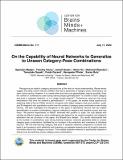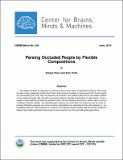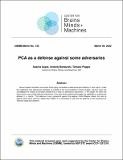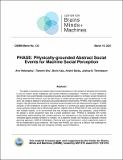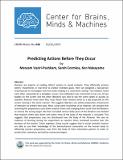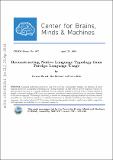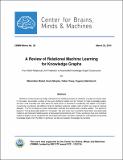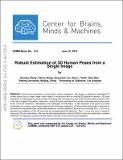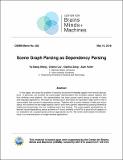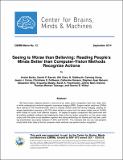Browsing CBMM Memo Series by Title
Now showing items 85-104 of 141
-
Object-Oriented Deep Learning
(Center for Brains, Minds and Machines (CBMM), 2017-10-31)We investigate an unconventional direction of research that aims at converting neural networks, a class of distributed, connectionist, sub-symbolic models into a symbolic level with the ultimate goal of achieving AI ... -
On Invariance and Selectivity in Representation Learning
(Center for Brains, Minds and Machines (CBMM), arXiv, 2015-03-23)We discuss data representation which can be learned automatically from data, are invariant to transformations, and at the same time selective, in the sense that two points have the same representation only if they are one ... -
On the Capability of Neural Networks to Generalize to Unseen Category-Pose Combinations
(Center for Brains, Minds and Machines (CBMM), 2020-07-17)Recognizing an object’s category and pose lies at the heart of visual understanding. Recent works suggest that deep neural networks (DNNs) often fail to generalize to category-pose combinations not seen during training. ... -
On the Forgetting of College Academice: at "Ebbinghaus Speed"?
(Center for Brains, Minds and Machines (CBMM), 2017-06-20)How important are Undergraduate College Academics after graduation? How much do we actually remember after we leave the college classroom, and for how long? Taking a look at major University ranking methodologies one can ... -
On the Robustness of Convolutional Neural Networks to Internal Architecture and Weight Perturbations
(Center for Brains, Minds and Machines (CBMM), arXiv, 2017-04-03)Deep convolutional neural networks are generally regarded as robust function approximators. So far, this intuition is based on perturbations to external stimuli such as the images to be classified. Here we explore the ... -
Parsing Occluded People by Flexible Compositions
(Center for Brains, Minds and Machines (CBMM), arXiv, 2015-06-01)This paper presents an approach to parsing humans when there is significant occlusion. We model humans using a graphical model which has a tree structure building on recent work [32, 6] and exploit the connectivity prior ... -
Parsing Semantic Parts of Cars Using Graphical Models and Segment Appearance Consistency
(Center for Brains, Minds and Machines (CBMM), arXiv, 2014-06-13)This paper addresses the problem of semantic part parsing (segmentation) of cars, i.e.assigning every pixel within the car to one of the parts (e.g.body, window, lights, license plates and wheels). We formulate this as a ... -
PCA as a defense against some adversaries
(Center for Brains, Minds and Machines (CBMM), 2022-03-30)Neural network classifiers are known to be highly vulnerable to adversarial perturbations in their inputs. Under the hypothesis that adversarial examples lie outside of the sub-manifold of natural images, previous work has ... -
PHASE: PHysically-grounded Abstract Social Events for Machine Social Perception
(Center for Brains, Minds and Machines (CBMM), The Thirty-Fifth AAAI Conference on Artificial Intelligence (AAAI), 2021, 2021-03-19)The ability to perceive and reason about social interactions in the context of physical environments is core to human social intelligence and human-machine cooperation. However, no prior dataset or benchmark has ... -
Predicting Actions Before They Occur
(Center for Brains, Minds and Machines (CBMM), 2015-10-26)Humans are experts at reading others’ actions in social contexts. They efficiently process others’ movements in real-time to predict intended goals. Here we designed a two-person reaching task to investigate real-time body ... -
Probing the compositionality of intuitive functions
(Center for Brains, Minds and Machines (CBMM), 2016-05-26)How do people learn about complex functional structure? Taking inspiration from other areas of cognitive science, we propose that this is accomplished by harnessing compositionality: complex structure is decomposed into ... -
Reconstructing Native Language Typology from Foreign Language Usage
(Center for Brains, Minds and Machines (CBMM), arXiv, 2014-04-25)Linguists and psychologists have long been studying cross-linguistic transfer, the influence of native language properties on linguistic performance in a foreign language. In this work we provide empirical evidence for ... -
Recurrent Multimodal Interaction for Referring Image Segmentation
(Center for Brains, Minds and Machines (CBMM), 2018-05-10)In this paper we are interested in the problem of image segmentation given natural language descriptions, i.e. referring expressions. Existing works tackle this problem by first modeling images and sentences independently ... -
Representation Learning in Sensory Cortex: a theory
(Center for Brains, Minds and Machines (CBMM), 2014-11-14)We review and apply a computational theory of the feedforward path of the ventral stream in visual cortex based on the hypothesis that its main function is the encoding of invariant representations of images. A key ... -
A Review of Relational Machine Learning for Knowledge Graphs
(Center for Brains, Minds and Machines (CBMM), arXiv, 2015-03-23)Relational machine learning studies methods for the statistical analysis of relational, or graph-structured, data. In this paper, we provide a review of how such statistical models can be “trained” on large knowledge graphs, ... -
Robust Estimation of 3D Human Poses from a Single Image
(Center for Brains, Minds and Machines (CBMM), arXiv, 2014-06-10)Human pose estimation is a key step to action recognition. We propose a method of estimating 3D human poses from a single image, which works in conjunction with an existing 2D pose/joint detector. 3D pose estimation is ... -
A role for recurrent processing in object completion: neurophysiological, psychophysical and computational evidence.
(Center for Brains, Minds and Machines (CBMM), arXiv, 2014-04-26)Recognition of objects from partial information presents a significant challenge for theories of vision because it requires spatial integration and extrapolation from prior knowledge. We combined neurophysiological recordings ... -
Scene Graph Parsing as Dependency Parsing
(Center for Brains, Minds and Machines (CBMM), 2018-05-10)In this paper, we study the problem of parsing structured knowledge graphs from textual descrip- tions. In particular, we consider the scene graph representation that considers objects together with their attributes and ... -
The Secrets of Salient Object Segmentation
(Center for Brains, Minds and Machines (CBMM), arXiv, 2014-06-13)In this paper we provide an extensive evaluation of fixation prediction and salient object segmentation algorithms as well as statistics of major datasets. Our analysis identifies serious design flaws of existing salient ... -
Seeing is Worse than Believing: Reading People’s Minds Better than Computer-Vision Methods Recognize Actions
(2015-12-10)We had human subjects perform a one-out-of-six class action recognition task from video stimuli while undergoing functional magnetic resonance imaging (fMRI). Support-vector machines (SVMs) were trained on the recovered ...



